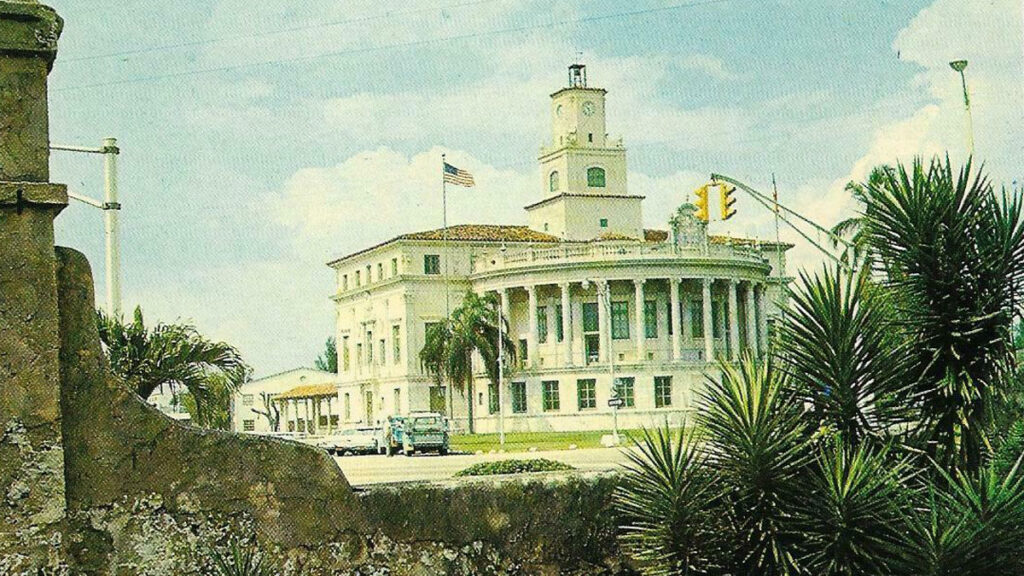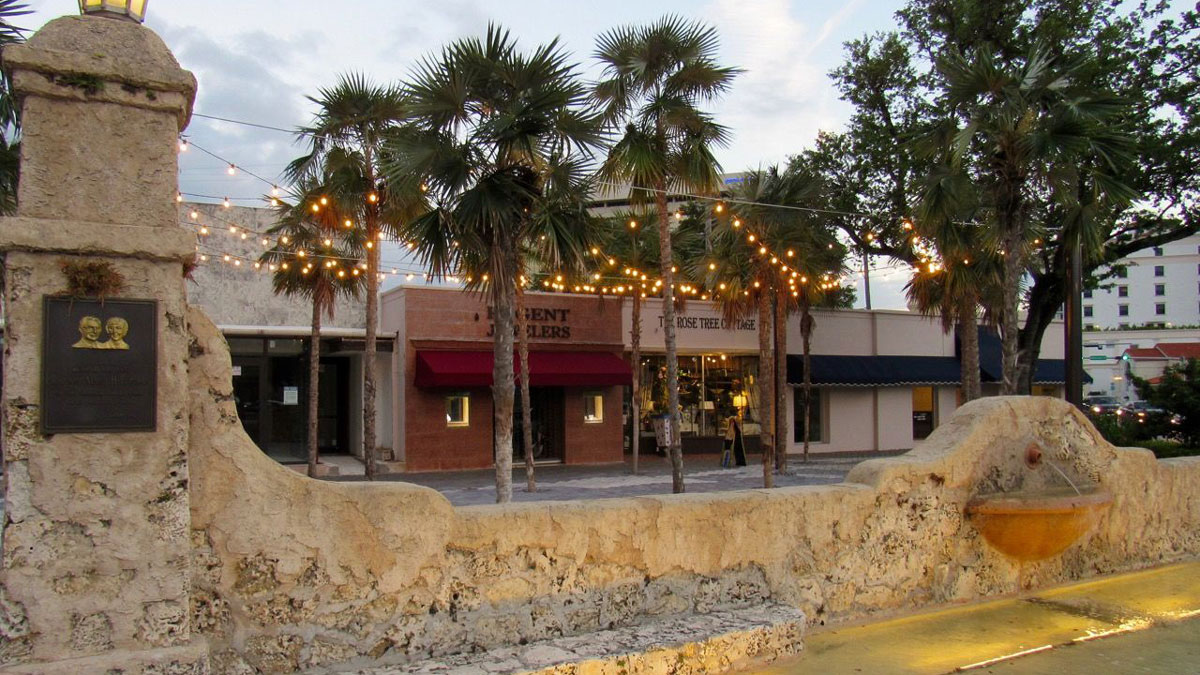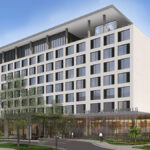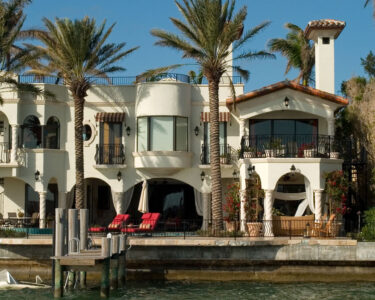The historic Miracle Mile has struggled with its identity since its inception.
In the 1920s, city founder George Merrick established the business section of Coral Gables and planted seeds for its healthy development. In the 1940s, developers led by George Zain saw the potential for the four blocks of undeveloped commercial property and began working to create a “miracle mile” as a unique shopping experience. In the 1980s, the historic preservation movement in Coral Gables and the public voiced concern over modern high-rises changing the character of the downtown area. In response, the then commission adopted the Zain/Friedman Overlay that includes on-site parking and a 70 feet (three stories) height restriction on properties fronting the Mile. Forty years later, the area’s historical character is once again threatened.
But what exactly has been gnawing Miracle Mile? One of the top reasons is the total disregard for its heritage by city leaders. The area has been the victim of poor stewardship and its original purpose has been forgotten.
Miracle Mile, according to the historical marker erected years ago, is “composed of small boutiques in the heart of the Central Business District and is one of the few remaining developments of its type that has maintained its original purpose and significance in the continental United States.” Sadly, the area’s historical value has been at best largely misunderstood or at worst completely ignored. Either way, it has been a missed economic gain for the City of Coral Gables.

According to a study commissioned by the U.S. Chamber of Commerce, American towns that make historic preservation a priority enjoy an economic dividend to the local economy. Additionally, heritage tourism has a greater impact on a local economy with heritage tourists spending 15% more than non-heritage tourists. Small and local businesses often show a preference for locating in historic commercial areas. In study after study, the rate of value increase in historic districts outperforms the market as a whole. As a matter of fact, just recently Miami Beach commissioners proposed creating a heritage business status that would recognize local businesses that meet certain requirements including “contributing to the history or identity of a particular neighborhood or community.”
In contrast, Coral Gables city government continues to follow a pro-development business model. The most recent experiment was spending millions of taxpayer dollars on a streetscape project that failed to revitalize the commercial district.
Years of closed streets have only led to closed shops. Whoever proposed aesthetics over assets missed the big picture and did not understand the economic value of a historic Miracle Mile. Dollars spent removing parking, widening sidewalks and adding new paving did not draw the economic relief so heralded. Neither will a zoning change to allow residential buildings. This proposed zoning change on the Mile will irreparably change the historical integrity of the commercial downtown community.
A mixed-use component has not succeeded in stimulating retail to the area, nor will it draw retailers. There is a concept in economics called “revealed preference” — consumers reveal their preference through their economic decisions. According to the U.S. Chamber study, “In cities large and small, consumers prefer living, shopping, visiting, and locating their businesses in historic neighborhoods. That built history in your community is not nostalgia — it is an economic asset.”
Miracle Mile enjoyed its heyday after World War II as a unique shopping destination that is “one of a few still remaining in the continental United States.” This economic asset has been ignored. Recently, elected officials, city administrators and business leaders have been calling for the modernization of Miracle Mile. This misaligned thinking goes in contrast to the U.S. Chamber’s study that supports making historic preservation an economic priority.
The Historic Miracle Mile has been misrepresented for too long. Reimagining the Mile as a historic commercial district offering a unique boutique shopping experience will be good for business. Studies support that historic districts outperform the market as a whole. And Miracle Mile can thrive if its heritage is preserved and promoted.
The Historic Preservation Association of Coral Gables is a 501c3 nonprofit founded in 1991. The Association promotes the understanding of the importance of historic resources and their preservation. For more information, please visit historiccoralgables.org.














 Deering Estate
Deering Estate
 Massage Envy South Miami
Massage Envy South Miami
 Calla Blow Dry
Calla Blow Dry
 My Derma Clinic
My Derma Clinic
 Sushi Maki
Sushi Maki
 Sports Grill
Sports Grill
 The Healthy Kitchen
The Healthy Kitchen
 Golden Rule Seafood
Golden Rule Seafood
 Malanga Cuban Café
Malanga Cuban Café

 Kathleen Ballard
Kathleen Ballard
 Panter, Panter & Sampedro
Panter, Panter & Sampedro
 Vintage Liquors
Vintage Liquors
 The Dog from Ipanema
The Dog from Ipanema
 Rubinstein Family Chiropractic
Rubinstein Family Chiropractic
 Your Pet’s Best
Your Pet’s Best
 Indigo Republic
Indigo Republic




 ATR Luxury Homes
ATR Luxury Homes


 2112 Design Studio
2112 Design Studio
 Hamilton Fox & Company
Hamilton Fox & Company
 Creative Design Services
Creative Design Services
 Best Pest Professionals
Best Pest Professionals
 HD Tree Services
HD Tree Services
 Trinity Air Conditioning Company
Trinity Air Conditioning Company
 Cisca Construction & Development
Cisca Construction & Development
 Mosquito Joe
Mosquito Joe
 Cutler Bay Solar Solutions
Cutler Bay Solar Solutions


 Miami Royal Ballet & Dance
Miami Royal Ballet & Dance
 Christopher Columbus
Christopher Columbus
 Pineview Preschools
Pineview Preschools
 Westminster
Westminster
 Carrollton
Carrollton
 Lil’ Jungle
Lil’ Jungle
 Frost Science Museum
Frost Science Museum
 Palmer Trinity School
Palmer Trinity School
 South Florida Music
South Florida Music
 Pinecrest Orthodontics
Pinecrest Orthodontics
 Dr. Bob Pediatric Dentist
Dr. Bob Pediatric Dentist
 d.pediatrics
d.pediatrics
 South Miami Women’s Health
South Miami Women’s Health

 The Spot Barbershop
The Spot Barbershop
 My Derma Clinic
My Derma Clinic




 Miami Dance Project
Miami Dance Project

 Rubinstein Family Chiropractic
Rubinstein Family Chiropractic
 Indigo Republic
Indigo Republic

 Safes Universe
Safes Universe
 Vintage Liquors
Vintage Liquors
 Evenings Delight
Evenings Delight





 Atchana’s Homegrown Thai
Atchana’s Homegrown Thai
 Baptist Health South Florida
Baptist Health South Florida

 Laser Eye Center of Miami
Laser Eye Center of Miami
 Visiting Angels
Visiting Angels
 OpusCare of South Florida
OpusCare of South Florida

 Your Pet’s Best
Your Pet’s Best





 HD Tree Services
HD Tree Services
 Hamilton Fox & Company
Hamilton Fox & Company


 Creative Design Services
Creative Design Services